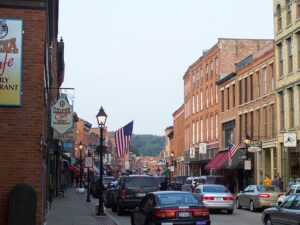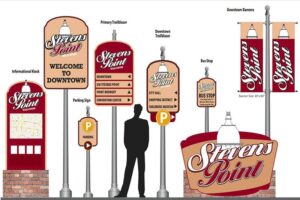
In my many years of working in the downtown development field, there is one thing I’ve found to be true: If asked, nearly every community will say they have a parking problem. Most of them say the problem is a lack of parking—but in fact, of the nearly 100 Main Street districts I’ve worked in, only two or three actually needed more parking. All the others had parking management issues, most of which could be addressed without adding a single space. In fact, in some cases, the situation was improved by removing some parking.
The thing to realize in historic commercial districts is that plentiful parking is not the reason people choose to visit these areas. Instead, they visit due to a mix of businesses and an exciting atmosphere, with older and historic buildings, walkable streetscapes and more. Most people in larger cities think nothing of having to park a few blocks from their destination because the area provides an experience.

Despite a legitimate lack of parking during peak times, downtown Galena, IL, still thrives because of its historic character and mix of businesses.
Even in smaller cities like Galena, Illinois, where one could argue there is a legitimate lack of parking, it doesn’t stop people from visiting because the downtown is so visually stunning and filled with so many restaurants and unique shops. Many walk nearly a mile to and from the nearest parking space.
There are a number of adages about this very phenomenon. One suggests that “anyplace worth a darn has a parking problem.” Another one says, “there’d be more people here if it weren’t so crowded.” And the group Revitalize or Die often encourages people to “stop worrying about where people will park and start worrying if they will show up.”
I can’t count the number of times I’ve had to talk a community out of demolishing a building in the core of its historic district to make way for parking. It is these older, historic buildings that give a district its character and help to set it apart from other districts. These buildings attract businesses, which, in turn, attract visitors, residents and investors. If we allow ourselves to tear even a few of these buildings down, it diminishes the character and appeal of the area, and gives people less of a reason to be there—and if people aren’t visiting, working or living there, then there certainly won’t be a need for those parking spaces.
More often than not, parking issues stem from one or more of the following:
- Confusion about available parking
- Abuses and enforcement
- Physical condition and design
One of the first things many new Main Street communities need help with is reversing negative images and/or promoting positive ones. One frequent negative perception is a lack of parking, whether real or perceived. As alluded to in the introduction, more often than not, it isn’t a lack of parking, but rather a parking management issue that exists. People simply do not know where the available parking is and which spaces are one-hour, three-hour, public, permit-only, etc.

The most effective parking signs are designed as part of a comprehensive wayfinding signage system. Graphic by Arnett Muldrow
One of the first recommendations we give to communities facing this is to conduct a thorough parking study that maps existing parking, existing building square footage, and existing sign locations; determines future parking needs; and surveys businesses and consumers. What is found in many cases is there are some areas of the district that are well-served, and others with fewer spaces. And furthermore, some areas are busier at certain times of the day than others. It is common when parking surveys are done that the business owners complain more about a lack of parking than their customers. Many business owners would love to have a sea of parking next to their building even if they don’t truly need it—so scrutiny of some of the responses is usually required.
As mentioned previously, it is rare that a Main Street district will need additional parking spaces. Some parking areas sit vacant most of the day, while others are over capacity. This may be because the empty lots are located too far away from where the demand is, but most often, it’s merely because people aren’t aware of the less-used parking. In these cases, effective signage and positive promotion can play a big part.
However, parking signage is often ineffective. There may be too much, there may not be enough, or it can be a mix of both that is causing the problem. The most effective parking signs are simple and easy to read and are part of a larger wayfinding signage system.
There are two main types of parking signs: those that lead you to the parking and those that let you know you’ve arrived. Both types should be simple and easy to read.



These simple and easy-to-read signs lead people to available parking.


Signs located at the lots let people know they’ve arrived at a parking area. These creative ones in Marshfield, WI, play on the city’s train heritage by using popular railroad names, including the aptly named Reading Railroad sign at the library.


These attractive signs in Augusta, GA, and Stillwater, MN, let people know where to enter and pay.
Once the existing parking is inventoried and mapped and the signage installed, the next step is to promote it. Many communities come up with creative slogans and design easy-to-use maps showing where the major parking areas are, then utilize them in printed brochures, on websites and on social media pages.


These simple logos and slogans are effective in Greenville, SC, and Idaho Falls, ID.


These maps in Columbus, GA, and Hyannis, MA, are used online and in printed brochures.


Royal Oak, MI encourages people to come downtown after the 9-5 work day by providing free or reduced parking if they arrive before 5 p.m.
In many cases, one of the biggest reasons for a perceived lack of parking is the fact that merchants, tenants and employees are parking in prime customer spaces. Some communities have tried tiered parking systems, where the further away parking lots are reserved for people who work and live downtown, while the ones located closer to the heart of the district are reserved for short-term use, typically two hours, which is ideal for most customers.


In some larger communities like Amarillo, TX, and Huntsville, AL, some parking areas allow people to park for longer than the posted time limit as long as they keep the meter fed. This can be a great way to encourage employees and tenants to park further away from prime customer spaces. They utilize online payment methods so the user doesn’t have to walk to the meter every time it needs to be fed.
Another reason for a less-than-effective parking system can be enforcement—either not enough or too much. Most communities see a lack of enforcement, usually due to funding and staffing issues. This allows people to abuse the posted time limits and park all day without a citation. In some cities, however, the enforcement is so stringent that people are afraid to park downtown at all because they will get a ticket if they’re 30 seconds late. Consistent and fair enforcement is always the best solution when it comes to posted hours.
When it comes to the parking itself, layout, design, appearance and safety are the most important factors. This is true of on-street parking as well as surface parking lots.
For on-street parking, a few different layouts are commonly in use, and the right one for a given street depends on the volume and speed of the traffic, as well as the width of the street. On high-volume roads, the on-street parking is typically parallel in layout, meaning the cars park parallel with the curb. While this method can be intimidating for some drivers, it takes up the least amount distance from the curb. It is also easier to accommodate bike lanes alongside parallel parking.


Parallel parking in Baltimore, MD, and Shullsburg, WI


Darlington, WI, utilizes a wide street and center median to allow for four lanes of parallel parking—two in each direction.
On less-traveled roads, angled parking is sometimes utilized. This makes it easy to pull into spaces, but arguably, it is far more difficult to back out without risking a collision with oncoming traffic. It also takes up virtually double the distance from the curb. The benefit is that more cars can fit along a lineal distance of curb than with parallel parking. However, this benefit is often negated by the fact that most roads can’t fit this type of parking on both sides of the street. Often a bike lane is incorporated along the opposite curb instead of behind the angled parking.



Two different layouts of angled parking in Garden City, KS, and Ruston, LA. The Garden City example on the left works because it’s a one-way street, which isn’t always desirable downtown. Most two-way streets, like the one in Ruston in the center, are too narrow to allow for two sides of angled parking. Some communities have tried back-in angled parking to mixed results. This example from Boise, ID, right, shows how one car’s driver clearly didn’t realize it was back-in.


If wide enough, some streets can accommodate 180-degree parking, like these examples in Columbia, SC, and Dodge City, KS.
In addition to on-street parking, nearly all communities have a number of surface lots that are used for public parking. It is important that these lots are well-lit and well-maintained, and that they make use of landscaping or fencing along the perimeter to create a visual buffer along the sidewalk. It is often recommended that downtown parking lots have an almost park-like appearance.


If wide enough, some streets can accommodate 180-degree parking, like these examples in Columbia, SC, and Dodge City, KS.


Surface lots should incorporate lighting and landscaping along the perimeter and even within the interior whenever possible.


Surface lots should incorporate lighting and landscaping along the perimeter and even within the interior whenever possible.


Perimeter buffering can even incorporate decorative pillars and fencing in addition to landscaping.
Communities should discourage private surface lots downtown unless absolutely necessary. These lots are usually created by demolishing older/historic buildings, which can be detrimental to creating a thriving, attractive district. In addition, when businesses are closed, the lots typically sit empty, making downtown look less active.


Private parking lots often look deserted after business hours, which can be detrimental to a downtown.
Communities should discourage private surface lots downtown unless absolutely necessary. These lots are usually created by demolishing older/historic buildings, which can be detrimental to creating a thriving, attractive district. In addition, when businesses are closed, the lots typically sit empty, making downtown look less active.
